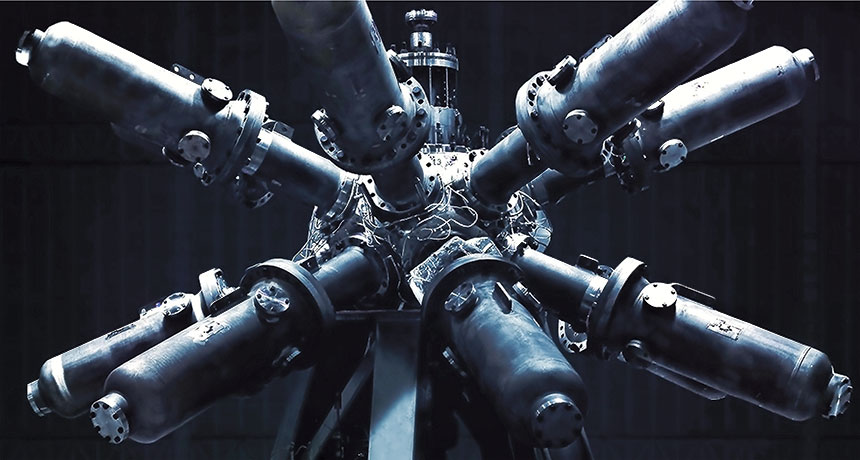
RENEGADE FUSION Private-sector startups, like General Fusion, are betting they can develop an energy source for the future faster than government-funded projects. General Fusion's prototype (shown) uses pistons that converge on magnetized, superhot plasma.
General Fusion
The lab where a company called General Fusion is trying to spark an energy revolution looks like a cross between a hardware store and a mad scientist’s lair. Bins full of electrical gadgets are piled high against the walls. Capacitors recycled from a bygone experiment are stacked up like bottles in wine racks. Ten-foot-high contraptions bristle with tangled wires and shiny plumbing.
Michael Delage, General Fusion’s vice president for strategy and corporate development, makes sure nothing is turned on when he takes a visitor through the lab, which is tucked away in a bland industrial park near Vancouver. He’s worried about the voltage.
“If you get a broken wire or something like that, you get a very loud bang,” Delage explains.
His company and others are looking for a bang of a different sort:
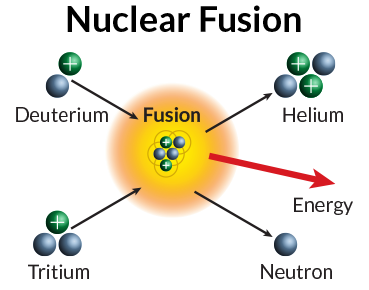
a smashing together of superhot hydrogen atoms that produces a net gain in energy. Nuclear fusion. It’s the same mass-to-energy reaction that’s behind the sun’s radiative power and the blast of a hydrogen bomb, but scaled down to a manageable level for power generation.
Government-funded research programs have spent tens of billions of dollars trying to harness fusion power during the last 60 years or so. Some are using superstrong magnetic fields to bottle up hydrogen gas that’s been heated up so much that it becomes plasma, a state of matter in which the electrons are stripped away from atomic nuclei. Others are blasting pellets of hydrogen fuel with powerful lasers or ion beams, causing tiny but powerful implosions.
Although they’ve come up short so far, the government-funded groups insist they’ll achieve controlled fusion sometime in the next couple of decades. For commercial fusion plants to deliver substantial amounts of electricity to power grids, however, will probably take until the 2040s or 2050s.
In contrast, General Fusion and at least 10 other commercial ventures say they can get fusion to pay off within a decade, at a cost of hundreds of millions of dollars rather than tens of billions. The upstarts are going with unorthodox approaches, ranging from piston-driven engines to devices that have more in common with particle accelerators than traditional nuclear reactors. And they’re finding deep-pocketed investors who are willing to cover the cost.
Not everyone is impressed.
“For the most part, these ideas are recycled from the glory days of the 1980s, and one by one, the Department of Energy stopped funding those concepts,” says Edward Morse, a nuclear engineer at the University of California, Berkeley. “It’s fortunate that the investors who are quoted in these reports are very rich people. They may not miss the money.”
But the start-ups insist they’re adding new twists to those decades-old principles. They plan to use computer simulations, innovative engineering and an entrepreneurial mindset to leapfrog the government projects.
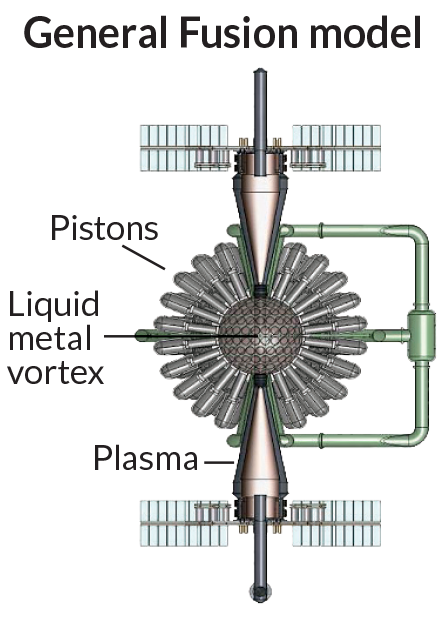
“You can’t do what we do for a million bucks,” says Michl Binderbauer, chief technology officer for Tri Alpha Energy, a fusion research company headquartered in Foothill Ranch, Calif. “There’s a certain level of capital expense that comes with doing frontier science.… But I don’t believe it takes billions of dollars. I really don’t.”
A big-money power play
If perfected, fusion power technology could be worth trillions.
Fusion power has several advantages over nuclear fission power, in which heavy atomic nuclei release energy upon splitting. The best-known fusion fuel, the heavy hydrogen isotope deuterium, can be extracted from seawater. There’d be no worries about long-lived highly radioactive waste, and a fusion reactor keeps so little fuel inside that it would naturally stop if something went wrong — avoiding the risk of a Fukushima-style meltdown or Chernobyl-style radiation leak.
Fusion power also eliminates worries about the fossil fuel emissions that are warming Earth’s climate. It would be a renewable energy source like solar and wind power, with some extra advantages. The reactors could be put anywhere to provide 24/7 power; no need for strong winds or bright sunshine.
“It really does have all the benefits you could ever want from a renewable energy source,” says Nathan Gilliland, General Fusion’s CEO. “One kilogram of hydrogen fuel has the same amount of energy as 10 million kilograms of coal. You’d have abundant fuel for hundreds of millions, billions of years.”
It’s that kind of enormous potential that has brought money pouring in to solve the fusion puzzle. Dozens of projects — from Astron to ZETA — have flowered and faded. The biggest project on the horizon is the ITER experimental reactor in Cadarache, France, which is backed by the United States and 34 other nations. ITER’s price tag and construction timetable have both ballooned beyond original estimates. The project is now due for completion in the mid-2020s at an estimated cost of $20 billion.
Once ITER is up and running, it’s expected to demonstrate a controlled fusion reaction that produces an energy surplus. But even under the best-case scenario, it would take until the 2040s to adapt ITER’s technology for use in a commercial power plant.
The Wendelstein 7-X stellarator, another advanced reactor, has just begun what’s expected to be a years-long experimental campaign in Greifswald, Germany. The German government has covered most of its $1 billion cost, but it’s far too early to tell if the technology can ever be commercialized.
ITER and Wendelstein 7-X both use a fusion approach called magnetic confinement. At the heart of each device is a chamber shaped like a doughnut (in Cadarache) or a pretzel (in Greifswald). Inside the chamber, a cloud of hot hydrogen plasma is squeezed by magnetic fields. An electromagnetic barrage heats the plasma so much that hydrogen nuclei fuse — creating helium atoms and neutrons while converting a smidgen of mass into electromagnetic radiation and kinetic energy.
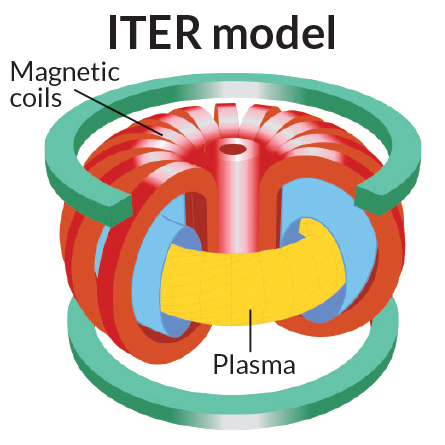
The other common strategy for fusion is called inertial confinement. This approach involves blasting pellets of hydrogen fuel with lasers or ion beams. The fuel is compressed so quickly and precisely that it’s held in place by its own inertia, allowing it to ignite in a burst of fusion energy.
The $3.5 billion National Ignition Facility at California’s Lawrence Livermore National Laboratory uses inertial confinement, but has fallen short. It doesn’t produce more energy than it consumes in the fusion reaction (SN: 3/8/14, p. 6).
Hybrid technology
A couple of the fusion start-ups — Tokamak Energy and First Light Fusion, both in the United Kingdom — are experimenting with their own twists on magnetic confinement or inertial confinement. But the best-funded private efforts are focusing on hybrid technologies alternately known as magnetized target fusion, field-reversed configuration or magneto-inertial fusion.
In magneto-inertial fusion, puffs of hydrogen are heated, then magnetized so that they hold together. Those magnetized puffs of plasma, which take on the shape of tiny smoke rings, are injected into a compression chamber, where they must be squeezed hard enough and fast enough to spark fusion.
Although the concept has been around for decades, magnetized target fusion was traditionally passed over in favor of the technologies behind ITER and the National Ignition Facility. That’s beginning to change. The Air Force Research Laboratory in New Mexico is using the method in an experiment known as FRCHX. Most of the work on magnetized target fusion, however, is happening at the private start-ups.
At General Fusion, for example, engineers are building steampunk-looking machines that they’ll eventually combine into a full-scale reactor. One contraption is designed to squirt plasma rings through a 10-foot-high, cone-shaped injector. In a different room, there’s a mechanical monster with black tubes reaching out in all directions.
When program manager Brendan Cassidy talks about the monstrous creation, he sounds like a mad scientist from the movies — but without the evil laugh. “We have successfully built the first device to pump liquid lead into a vortex, and use an acoustic driver to collapse the vortex,” he says proudly.
In the full-scale reactor, two rings of magnetized plasma — consisting of deuterium and tritium, a radioactive isotope of hydrogen — will be shot toward each other in a chamber with a spinning vortex of liquid lead and lithium. The pistons surrounding the chamber should slam the metal around the plasma hard enough to set off a fusion reaction.
The resulting energy will heat the molten lead even more. That liquid metal will circulate through a heat exchanger, turning water into steam to drive a power-generating turbine. Some of the lithium will be transformed into tritium to fuel further reactions.
For its full-scale prototype, General Fusion will expand the plasma chamber from 1 meter wide to 3 meters. The number of pistons will grow from 14 to 220, bringing the setup to about 10 meters wide. If that next machine works the way researchers hope, they’ll get a successful fusion shot once or twice a day. To commercialize the technology, they’ll need a more advanced reactor firing an energy-generating shot every second.
When it’s time to commercialize, General Fusion would license the technology to the power industry. “If we ever succeed, we will partner with the GEs of this world,” says Michel Laberge, the physicist who founded General Fusion.
Story continues after sidebar
Many roads to fusion
While government programs focus on magnetic and inertial confinement, private ventures try hybrid approaches.
Magnetic Confinement Fusion: Powerful magnetic fields contain a hot plasma of fusion fuel inside a chamber, and electromagnetic waves are injected into the plasma to raise the temperature high enough for fusion.
Inertial Confinement Fusion: A pulse of high energy is focused on a target quickly and precisely, squeezing the target and heating it to fusion conditions.
Magneto-inertial Fusion: Puffs of hot plasma are magnetized, then directed at each other under conditions that squeeze the plasma hard enough and long enough for fusion to occur.
The image below represents different fusion ventures.

Sources: ITER; MPG-IPP; D. Clery/Science 2015; “An Assessment of the Prospects for Inertial Fusion Energy”/NRC 2013; General Fusion; Tri Alpha Energy; Helion Energy
Nixing the neutrons
Tri Alpha Energy is borrowing physics principles from particle colliders to pursue its own brand of magnetic fusion. In Tri Alpha’s reactor design, starter plasmas are formed by merging two magnetized plasma rings. The compound plasmas are then sustained by high-energy particles from accelerators. “It will work as an energy amplifier,” Tri Alpha’s Binderbauer says.
Most fusion ventures, including ITER and General Fusion, plan to use deuterium plus tritium to fuel the reaction. Tri Alpha is trying a less-orthodox combination: hydrogen nuclei — that is, single protons — and boron-11 ions.
Tri Alpha’s concept has some advantages. It relies on naturally occurring fuels rather than unstable tritium, which must be bred in a nuclear reaction like the one in General Fusion’s machine. What’s more, the proton-boron reaction, known as p-B11, is more benign than the deuterium-tritium reaction, known as D-T (SN: 11/2/13, p. 8).
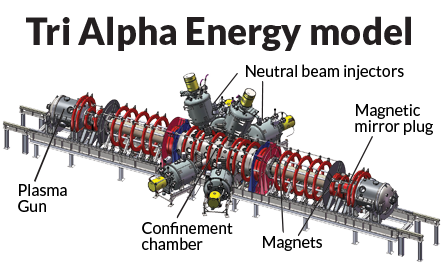
Each D-T reaction produces a helium nucleus (two protons and two neutrons) plus a neutron. The resulting flux of neutrons poses a radiation hazard and can degrade whatever material is being used to shield the reactor. The p-B11 reaction gives off energy without producing stray neutrons. Such aneutronic fusion is especially attractive for commercial operations.
However, achieving fusion is a lot more difficult with p-B11 than with D-T. The plasma must reach temperatures in excess of 3 billion degrees Celsius, as opposed to 100 million degrees for D-T fusion. But Binderbauer says the potential payoff is worth it.
“You’re trading harder science up front for easier engineering down the hill,” he says.
General Fusion and Tri Alpha Energy have both been around for more than a decade, but they are just beginning to publish intriguing findings in peer-reviewed journals. In a pair of papers published last April and May in Nature Communications and AIP Physics of Plasmas, Tri Alpha’s researchers reported that they held 10-million-degree hydrogen plasma steady in a test reactor for 5 milliseconds.
Five milliseconds may not sound like a long time, but it marked a milestone for fusion start-ups. “If we had enough power to continually pump into it … we believe we could maintain the plasma at will,” Richard Barth, Tri Alpha’s senior vice president for government relations, said in December at a forum in Washington, D.C., sponsored by the American Security Project.
Tri Alpha says its next, bigger reactor, C-2W, should heat plasma to much higher temperatures. Within three or four years, that machine is expected to come close to sparking a sustained D-T fusion reaction. If C-2W performs as expected, Binderbauer says, he expects Tri Alpha will build an even more powerful machine and try p-B11 fusion.
Instead of using a steam turbine to convert heat into electricity, Tri Alpha’s machine would use a more efficient method to convert the flow of particles into electrical current. Binderbauer expects to take the first steps toward commercialization in a decade, if all goes well.
Fast-track fusion
Just a few miles from Microsoft’s headquarters outside Seattle, Helion Energy wants to fuse deuterium and helium-3 to produce energy plus hydrogen and helium-4 nuclei, but no neutrons. Pulsed magnetic fields would compress and heat the plasma to fusion temperatures for a brief instant.
Like General Fusion’s machine, Helion’s fusion engine would set off bursts at the rate of one per second. And like Tri Alpha’s machine, the system would convert the energy directly into electricity. One of Helion’s fusion-fuel ingredients, helium-3, is rare on Earth. It happens to be abundant on the moon, which is why helium-3 is often cited as a justification for lunar mining schemes. Fortunately, Helion won’t have to race to the moon. The reactor is designed to synthesize its own helium-3, just as General Fusion’s machine is designed to synthesize tritium.
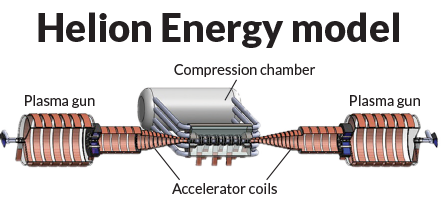
David Kirtley, a fusion researcher and Helion CEO, says the company could demonstrate a net-gain fusion reaction within a couple of years and make fusion power marketable by 2022.
Magnetized target fusion and its variants aren’t the only unorthodox technologies on the fast track. Lawrenceville Plasma Physics, based in New Jersey, is developing a device that would zap hydrogen-boron fuel with a jolt of electricity, in a process known as dense plasma focus.
Other companies are working on cusp confinement, which involves trapping and squeezing ionized gas between magnetic fields. Lockheed Martin’s Skunk Works lab in Palmdale, Calif., is pursuing this approach to build a compact fusion reactor by 2025 that it hopes will be suitable for installation on airplanes. EMC2 Fusion Development, based in Santa Fe, N.M., tested a cusp-confinement device for the U.S. Navy in 2014 and is looking for investors to fund a larger version.
High-profile investors
Can private enterprise really do fusion cheaper and quicker than the multibillion-dollar, government-led efforts? Hard to imagine, but investors backing the efforts are risk takers.
Tri Alpha has brought in hundreds of millions of dollars in investment, from backers that include Microsoft cofounder Paul Allen. General Fusion has attracted $94 million in funding, with Amazon founder Jeff Bezos among the investors. Last July, an investment group with connections to Canadian billionaire Jeff Skoll put money into a $10 million funding round for Helion Energy. Fellow billionaire Peter Thiel, a cofounder of PayPal, is also a Helion investor.
Even government agencies are supporting the private ventures: The U.S. Department of Energy supports low-cost approaches to fusion through ARPA-E, the Advanced Research Projects Agency-Energy. In 2015, ARPA-E awarded $30 million to nine alternative fusion ventures, including nearly $4 million to Helion Energy. General Fusion has benefited from a similar program in Canada.
The public funding of these private endeavors raises a pointed question: If even one of the low-cost commercial strategies has a chance of working, why spend billions on the traditional big-budget programs?
“When you invest, you have some blue-chip stocks, and you have some high-payoff stocks,” says Uri Shumlak, a nuclear engineer at the University of Washington whose fusion research received $4.8 million from ARPA-E. “The projects being funded by ARPA-E are high-risk, high-payoff ventures.”
It all sounds like a gamble, but there’s one sure thing: As climate concerns rise and fossil fuel reserves shrink, meeting the world’s rising energy needs is a game that has to be won — even if it takes a mad-scientist lab to do it.
This article appears in the February 6, 2016, issue of Science News under the headline, “Renegade Fusion.”
Editor’s Note: This article was updated on January 29, 2016, to correct some descriptions of Tri Alpha Energy’s fusion approach.







